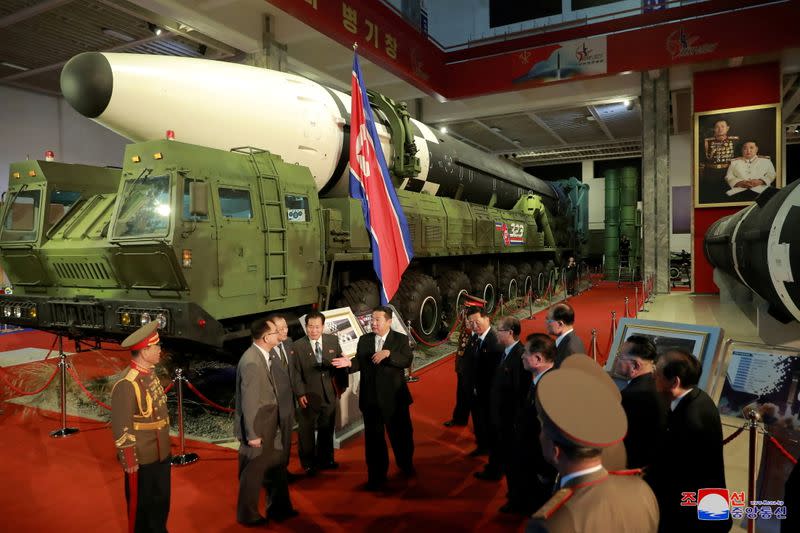Analysis-N.Korea threatens to upstage S.Korea defence expo with duelling military show

By Josh Smith
SEOUL (Reuters) - South Korea will hold its biennial defence fair in Seoul next week, just days after North Korea opened a highly unusual military exhibition that analysts said may be partly aimed at stealing some thunder from Seoul amid a growing arms race.
The events highlight the latest developments both Koreas have made as they press forward with major expansions of already substantial military capabilities - including sometimes mirror-image moves.
"North Korea must have purposefully timed their defence exhibition this week to gain traction from the international community ahead of South Korea's scheduled show to sell their weapons systems abroad," said Cho Jin-soo, former president of the Korean Society for Aeronautical and Space Sciences. "They are piggybacking on the South to sell the weapons and delivering a message of 'forget me not.'”
Seoul International Aerospace & Defense Exhibition (ADEX) has been held every two years since 2009, in contrast to North Korea's, which was not announced in advance.
"There's likely to have been a number of considerations that resulted in this event, however, not least of which the fact that they appear to be gearing up for another period of increased tensions and confrontation," said Joost Oliemans, a specialist focused on North Korean military capabilities.
In a speech opening the exhibition on Monday, leader Kim Jong Un pointed to a military buildup by South Korea as one justification for the North's military, and reiterated complaints that North Korea's defence developments are treated differently than those in other countries.
A TALE OF TWO ARMS FAIRS
Although superficially similar and conspicuously timed, the two events are quite different, and the two Koreas do not compete for the same customers.
Sanctioned over its nuclear programme and with borders closed to prevent a COVID-19 outbreak, North Korea's event has been visited by officials from around the country, according to state media, but no major international delegations.
In recent years a United Nations panel of experts monitoring international sanctions has accused North Korea of continuing to export arms, and conduct military cooperation with countries such as Syria and Myanmar.
Festooned with paintings and other images of Kim, the North Korean show is also as much about idolizing the country's leader as displaying new weapons, said Rachel Minyoung Lee, an analyst with the 38 North project, which tracks North Korea.
South Korea, meanwhile, says ADEX will feature 440 companies from 28 countries. About 300 military and defence officials from 45 countries, including defence ministers, are expected to attend, organisers have said.
Displays are expected to include South Korea's latest defence technology, including hydrogen-fueled drones, virtual reality-based training systems, laser weapons, and multi-purpose unmanned vehicles.
The centrepiece will be South Korea's prototype KF-21 next-generation fighter jet, as well as guided weapons such as missiles, said an aviation expert with the knowledge of the plans. South Korea will likely be eyeing potential international vendors to provide it with tanker aircraft technology.
Other, more civilian-focused displays will feature "urban air mobility" technology for air taxis, and satellite launch rockets, the expert said.
Kang Eun-ho, South Korea's minister for the Defense Acquisition Program Administration (DAPA), declined to comment on any potential deals in the works during ADEX, but told reporters on Thursday that he hoped the show provides an opportunity to "read the arc and trend" of global defence developments.
GROWING WEAPONS PROGRAMMES
Kallman Worldwide, a company that organises the U.S. presence at aerospace and defence shows around the world, said "nuclear sabre-rattling" by North Korea as well as efforts to defuse those tensions through diplomacy have made ADEX "uniquely framed with extra urgency and intrigue."
"Driving the discussion, defence budget increases largely aimed at countering Kim Jong Un’s nuclear programs are spiking supplier interest in the show," the company said in a pitch for ADEX on its website.
South Korea has approved major increases in its defence budget in recent years, aiming to counter the North and wean itself off American support while expanding its military export industry.
The Ministry of National Defense has proposed a defence budget of 55.23 trillion won ($47.6 billion) for 2022, a year-on-year increase of 4.5%.
North Korea's decision to stage its exhibition - complete with data cards for each weapon - was "very rare" for a country that more typically shows off its arsenal in parades, said Joseph Dempsey, a defence researcher at the International Institute for Strategic Studies.
Among the potential new weapons were a ballistic missile with an apparent manoeuvrable re-entry vehicle, which would allow the warhead to steer itself toward its target; and a previously unseen missile displayed next to the North's submarine-launched ballistic missiles (SLBM).
The mystery missile is smaller than existing SLBMs, potentially presenting an easier pathway to an operational ballistic missile submarine, which South Korea has recently demonstrated with an SLBM launch, Dempsey said.
When asked about North Korea's show, the South's defence ministry said it was assessing the displayed weapons in coordination with the United States.
A large number of conventional weapons were also displayed, including anti-ship, anti-tank and surface-to-air missiles, drones, and new small arms such as sniper rifles, Oliemans said.
"What we're seeing is a mixture of recently developed systems and prototypical designs," he said.
(Reporting by Josh Smith; Additional reporting by Sangmi Cha. Editing by Gerry Doyle)

